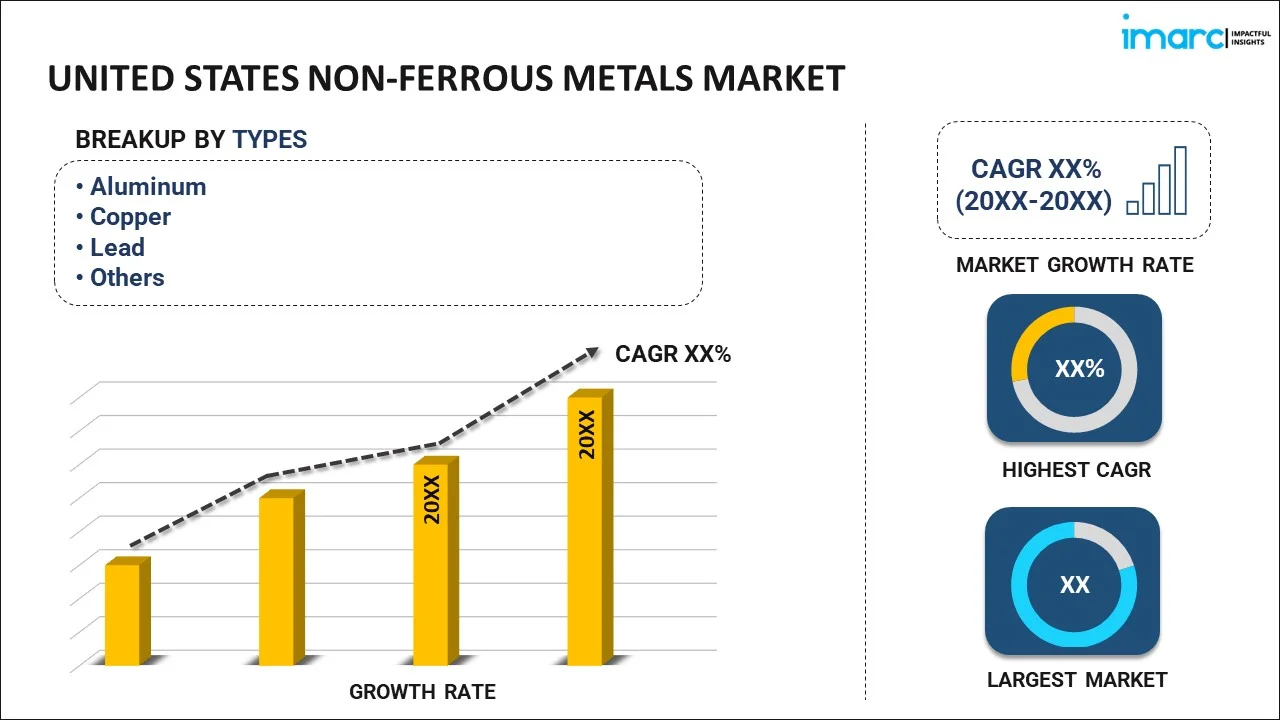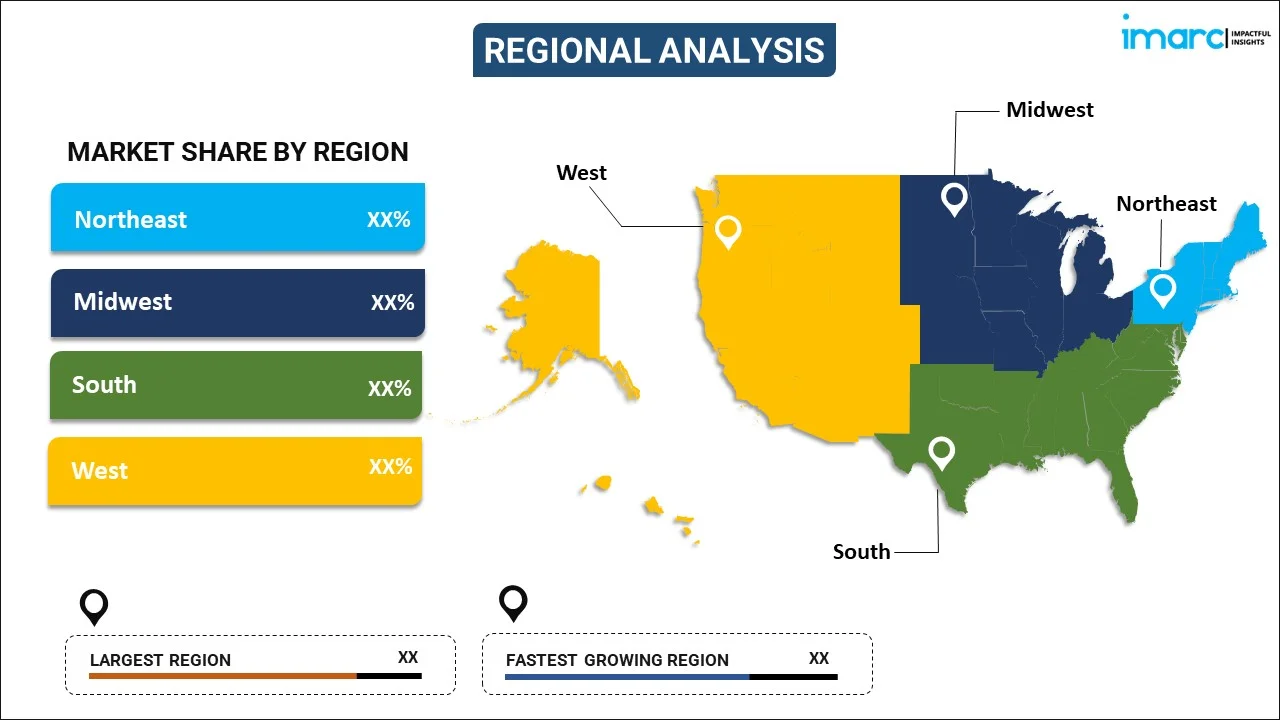
United States Non-Ferrous Metals Market Report by Type (Aluminum, Copper, Lead, Tin, Nickel, Titanium, Zinc, and Others), Application (Automobile Industry, Electronic Power Industry, Construction Industry, and Others), and Region 2024-2032
Market Overview:
United States non-ferrous metals market market size reached US$ 172.34 Billion in 2023. Looking forward, IMARC Group expects the market to reach US$ 283.83 Billion by 2032, exhibiting a growth rate (CAGR) of 5.20% during 2024-2032. The growing focus on reducing the weight of vehicles without compromising structural integrity, rising development of advanced batteries for electric vehicles (EVs), and advancements in metallurgy and manufacturing processes represent some of the key factors driving the market.
|
Report Attribute
|
Key Statistics
|
|---|---|
|
Base Year
|
2023 |
|
Forecast Years
|
2024-2032 |
|
Historical Years
|
2018-2023
|
| Market Size in 2023 | US$ 172.34 Billion |
| Market Forecast in 2032 | US$ 283.83 Billion |
| Market Growth Rate (2024-2032) | 5.20% |
Non-ferrous metals comprise a wide range of materials, such as aluminum, copper, lead, zinc, nickel, tin, titanium, and magnesium. They can be easily shaped, molded, and alloyed to meet specific requirements of several industries. They are resistant to rust and corrosion as compared to ferrous metals, which makes them valuable in numerous industrial applications. They are lightweight and offer enhanced conductivity and malleability. They are highly recyclable, reduce the need for mining, and conserve natural resources, which makes them eco-friendly. They offer heat-resistant properties and can withstand high temperatures without losing their structural integrity. They can also endure mechanical stress and wear and tear while ensuring reliable performance over extended periods. They play an essential role in ensuring the efficient flow of electricity in various applications, ranging from residential wiring to industrial machinery. As they assist in reducing energy consumption, lowering greenhouse gas (GHG) emissions, and maintaining environmental sustainability, the demand for non-ferrous metals is rising in the United States.
United States Non-Ferrous Metals Market Trends:
Presently, the escalating demand for copper and bronze metals in architectural design and artistic creations due to their attractive appearance represents one of the major factors influencing the market positively in the United States. Additionally, the increasing use of aluminum and titanium metals in the automotive sector for reducing weight without compromising structural integrity is propelling the growth of the market in the country. Apart from this, there is a rise in the demand for non-ferrous metals due to their recyclability and lower environmental impact. This, coupled with the growing utilization of non-ferrous metals for components like solar panels, wind turbines, and energy storage systems, is offering a positive market outlook in the country. Moreover, the increasing employment of titanium and stainless steel metals in medical implants and instruments, as they are biocompatible and have corrosion resistant properties is bolstering the growth of the market. In line with this, the rising adoption of non-ferrous metals for wiring, circuit boards, and casings in electronic devices, such as smartphones and laptops, is strengthening the market growth in the US. Furthermore, advancements in metallurgy and manufacturing processes assist in improving the properties and applications of non-ferrous metals, which is contributing to the market growth in the country. In addition, the increasing use of non-ferrous metals like lithium, nickel, and cobalt to develop advanced batteries for electric vehicles (EVs) are providing lucrative growth opportunities to industry investors. The escalating demand for non-ferrous metals in the construction industry due to their enhanced durability is also impelling the market growth.
United States Non-Ferrous Metals Market Segmentation:
IMARC Group provides an analysis of the key trends in each segment of the market, along with forecasts at the country level for 2024-2032. Our report has categorized the market based on type and application.
Type Insights:

- Aluminum
- Copper
- Lead
- Tin
- Nickel
- Titanium
- Zinc
- Others
The report has provided a detailed breakup and analysis of the market based on the type. This includes aluminum, copper, lead, tin, nickel, titanium, zinc, and others.
Application Insights:
- Automobile Industry
- Electronic Power Industry
- Construction Industry
- Others
A detailed breakup and analysis of the market based on the application have also been provided in the report. This includes automobile industry, electronic power industry, construction industry, and others.
Regional Insights:

- Northeast
- Midwest
- South
- West
The report has also provided a comprehensive analysis of all the major regional markets, which include Northeast, Midwest, South, and West.
Competitive Landscape:
The market research report has also provided a comprehensive analysis of the competitive landscape. Competitive analysis such as market structure, key player positioning, top winning strategies, competitive dashboard, and company evaluation quadrant has been covered in the report. Also, detailed profiles of all major companies have been provided.
United States Non-Ferrous Metals Market Report Coverage:
| Report Features | Details |
|---|---|
| Base Year of the Analysis | 2023 |
| Historical Period | 2018-2023 |
| Forecast Period | 2024-2032 |
| Units | US$ Billion |
| Scope of the Report | Exploration of Historical Trends and Market Outlook, Industry Catalysts and Challenges, Segment-Wise Historical and Future Market Assessment:
|
| Types Covered | Aluminum, Copper, Lead, Tin, Nickel, Titanium, Zinc, Others |
| Applications Covered | Automobile Industry, Electronic Power Industry, Construction Industry, Others |
| Regions Covered | Northeast, Midwest, South, West |
| Customization Scope | 10% Free Customization |
| Report Price and Purchase Option | Single User License: US$ 3699 Five User License: US$ 4699 Corporate License: US$ 5699 |
| Post-Sale Analyst Support | 10-12 Weeks |
| Delivery Format | PDF and Excel through Email (We can also provide the editable version of the report in PPT/Word format on special request) |
Key Questions Answered in This Report:
- How has the United States non-ferrous metals market performed so far and how will it perform in the coming years?
- What has been the impact of COVID-19 on the United States non-ferrous metals market?
- What is the breakup of the United States non-ferrous metals market on the basis of type?
- What is the breakup of the United States non-ferrous metals market on the basis of application?
- What are the various stages in the value chain of the United States non-ferrous metals market?
- What are the key driving factors and challenges in the United States non-ferrous metals?
- What is the structure of the United States non-ferrous metals market and who are the key players?
- What is the degree of competition in the United States non-ferrous metals market?
Key Benefits for Stakeholders:
- IMARC’s industry report offers a comprehensive quantitative analysis of various market segments, historical and current market trends, market forecasts, and dynamics of the United States non-ferrous metals market from 2018-2032.
- The research report provides the latest information on the market drivers, challenges, and opportunities in the United States non-ferrous metals market.
- Porter's five forces analysis assist stakeholders in assessing the impact of new entrants, competitive rivalry, supplier power, buyer power, and the threat of substitution. It helps stakeholders to analyze the level of competition within the United States non-ferrous metals industry and its attractiveness.
- Competitive landscape allows stakeholders to understand their competitive environment and provides an insight into the current positions of key players in the market.
Need more help?
- Speak to our experienced analysts for insights on the current market scenarios.
- Include additional segments and countries to customize the report as per your requirement.
- Gain an unparalleled competitive advantage in your domain by understanding how to utilize the report and positively impacting your operations and revenue.
- For further assistance, please connect with our analysts.
 Inquire Before Buying
Inquire Before Buying
 Speak to an Analyst
Speak to an Analyst
 Request Brochure
Request Brochure
 Request Customization
Request Customization




.webp)




.webp)












